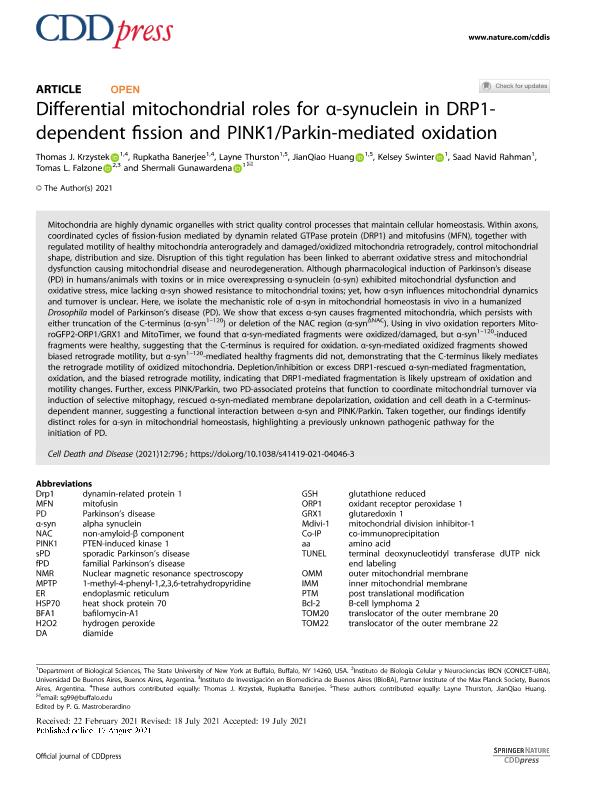Artículo
Differential mitochondrial roles for α-synuclein in DRP1-dependent fission and PINK1/Parkin-mediated oxidation
Krzystek, Thomas J.; Banerjee, Rupkatha; Thurston, Layne; Huang, JianQiao; Swinter, Kelsey; Rahman, Saad Navid; Falzone, Tomas Luis ; Gunawardena, Shermali
; Gunawardena, Shermali
 ; Gunawardena, Shermali
; Gunawardena, Shermali
Fecha de publicación:
05/2021
Editorial:
Springer Nature
Revista:
Cell Death and Disease
ISSN:
2041-4889
Idioma:
Inglés
Tipo de recurso:
Artículo publicado
Clasificación temática:
Resumen
Mitochondria are highly dynamic organelles with strict quality control processes that maintain cellular homeostasis. Within axons, coordinated cycles of fission-fusion mediated by dynamin related GTPase protein (DRP1) and mitofusins (MFN), together with regulated motility of healthy mitochondria anterogradely and damaged/oxidized mitochondria retrogradely, control mitochondrial shape, distribution and size. Disruption of this tight regulation has been linked to aberrant oxidative stress and mitochondrial dysfunction causing mitochondrial disease and neurodegeneration. Although pharmacological induction of Parkinson’s disease (PD) in humans/animals with toxins or in mice overexpressing α-synuclein (α-syn) exhibited mitochondrial dysfunction and oxidative stress, mice lacking α-syn showed resistance to mitochondrial toxins; yet, how α-syn influences mitochondrial dynamics and turnover is unclear. Here, we isolate the mechanistic role of α-syn in mitochondrial homeostasis in vivo in a humanized Drosophila model of Parkinson’s disease (PD). We show that excess α-syn causes fragmented mitochondria, which persists with either truncation of the C-terminus (α-syn1–120) or deletion of the NAC region (α-synΔNAC). Using in vivo oxidation reporters Mito-roGFP2-ORP1/GRX1 and MitoTimer, we found that α-syn-mediated fragments were oxidized/damaged, but α-syn1–120-induced fragments were healthy, suggesting that the C-terminus is required for oxidation. α-syn-mediated oxidized fragments showed biased retrograde motility, but α-syn1–120-mediated healthy fragments did not, demonstrating that the C-terminus likely mediates the retrograde motility of oxidized mitochondria. Depletion/inhibition or excess DRP1-rescued α-syn-mediated fragmentation, oxidation, and the biased retrograde motility, indicating that DRP1-mediated fragmentation is likely upstream of oxidation and motility changes. Further, excess PINK/Parkin, two PD-associated proteins that function to coordinate mitochondrial turnover via induction of selective mitophagy, rescued α-syn-mediated membrane depolarization, oxidation and cell death in a C-terminus-dependent manner, suggesting a functional interaction between α-syn and PINK/Parkin. Taken together, our findings identify distinct roles for α-syn in mitochondrial homeostasis, highlighting a previously unknown pathogenic pathway for the initiation of PD.
Palabras clave:
TRANSPORTE AXONAL
,
PARKINSON
,
SINUCLEINA
Archivos asociados
Licencia
Identificadores
Colecciones
Articulos(IBCN)
Articulos de INST.DE BIOLO.CEL.Y NEURCS."PROF.E.DE ROBERTIS"
Articulos de INST.DE BIOLO.CEL.Y NEURCS."PROF.E.DE ROBERTIS"
Articulos(IBIOBA - MPSP)
Articulos de INST. D/INV.EN BIOMED.DE BS AS-CONICET-INST. PARTNER SOCIEDAD MAX PLANCK
Articulos de INST. D/INV.EN BIOMED.DE BS AS-CONICET-INST. PARTNER SOCIEDAD MAX PLANCK
Citación
Krzystek, Thomas J.; Banerjee, Rupkatha; Thurston, Layne; Huang, JianQiao; Swinter, Kelsey; et al.; Differential mitochondrial roles for α-synuclein in DRP1-dependent fission and PINK1/Parkin-mediated oxidation; Springer Nature; Cell Death and Disease; 12; 9; 5-2021; 1-16
Compartir
Altmétricas



